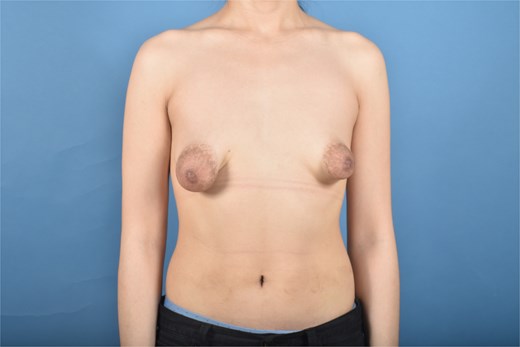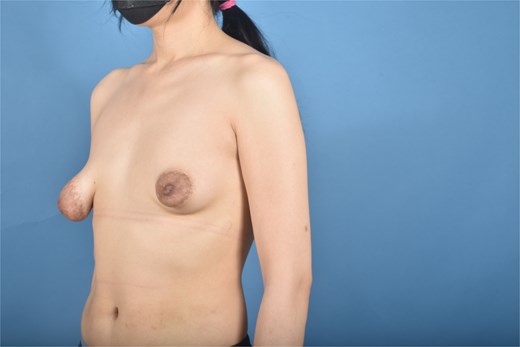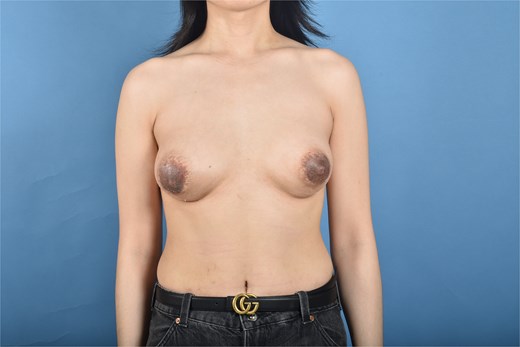-
PDF
- Split View
-
Views
-
Cite
Cite
Yasmine Ibrahim, Siam K Rezwan, Aman Tahir, Michael R DeLong, Tuberous breast deformity in a transgender woman: a case report, Journal of Surgical Case Reports, Volume 2025, Issue 9, September 2025, rjaf694, https://doi.org/10.1093/jscr/rjaf694
Close - Share Icon Share
Abstract
Tuberous breast deformity was first documented by Rees and Aston in 1976. The deformity is well documented in cisgender women, with rare cases in cisgender men often associated with gynecomastia, and almost no reports in transgender women. Herein, we present a case of a 32-year-old transgender woman who developed bilateral tuberous breast deformity after 10 years of hormone replacement therapy. This report highlights the rarity of the condition in transgender women, discusses its clinical presentation, and its surgical management. Given the growing number of transgender individuals undergoing gender-affirming care, recognizing and addressing such anatomical variations is crucial for optimizing surgical outcomes.
Introduction
Tuberous breast deformity was first documented by Rees and Aston in 1976 [1]. The deformity is well documented in cisgender women, with rare cases in cisgender men often associated with gynecomastia, and almost no reports in transgender women [2].
Gender-affirming care for transgender women includes various medical and surgical interventions. Hormone replacement therapy (HRT) plays a central role in feminization, typically involving exogenous estrogen and antiandrogens, such as spironolactone, to induce breast development through increased fat deposition and ductal formation [3]. Although HRT promotes breast growth, it does not always yield sufficient breast volume or the desired aesthetic outcomes, leading many transgender women to seek breast augmentation. Studies report breast augmentation rates of up to 67% among transgender women [4].
The anatomical differences between cisgender and transgender women pose unique surgical challenges. These include reduced volume of subcutaneous tissue in the upper and lower poles, an oval and laterally positioned nipple–areolar complex (NAC), and a less defined inframammary fold compared to cisgender women [5, 6]. Tuberous breast deformity is a condition that is characterized by a constricted breast base, enlarged NAC, and lack of adequate vertical and horizontal dimensions [7]. While well documented in cisgender women, cases in transgender individuals remain significantly unexplored. This report presents a unique case of tuberous breast deformity in a transgender woman undergoing HRT, discussing its clinical implications and management.
Case presentation
A 32-year-old transgender woman presented to our department with concerns regarding breast shape and volume. The patient had been on hormonal estrogen and spironolactone therapy for 10 years and achieved moderate breast development. However, the patient expressed dissatisfaction with her current breast morphology. On physical examination, the patient demonstrated classic features of tuberous breast deformity, including a constricted breast base, hypoplastic lower pole, high inframammary fold, and herniation of the NAC. Bilateral involvement was noted, with moderate asymmetry. Measurements included a sternal notch-to-nipple distance of 25 cm and a nipple-to-inframammary fold distance of 8 cm, base width of 10 cm, and areolar diameter of 6 cm bilaterally (Figs 1 and 2). Using the classification of von Heimburg et al., the tuberous breast deformity could be classified as type 4 bilaterally [8]. There was a constricted breast base, hypoplastic lower pole, high inframammary fold, and herniation of the NAC (Figs 1 and 2).


With patient consent, we performed a bilateral breast augmentation and NAC herniation repair. A 38 mm cookie cutter was used to mark bilateral nipple internal diameters. The inferior portion of this marking was then incised to ultimately create a subglandular pocket for an implant. Once sizers were placed, the correction of the NAC herniation was simulated with tailor tacking. The outer diameter was marked. Once acceptable symmetry and contour were achieved, the sizers were removed, and the pockets were irrigated with triple antibiotic plus betadine. Final implants (Natrelle Inspira Cohesive Breast Implant, SSLP 205) were inserted into bilateral pockets with a Keller funnel and no touch technique. A deep stitch was placed on both sides with 3-0 Vicryl, although the inferior capsular support was limited. The outer diameter of the areolae that had been marked was then incised and the remainder of the inner diameter was incised. Intervening tissue was de-epithelialized. The areolae were then reduced in between, a total area 10 cm2 per side. The incisions were closed with 3-0 and 4-0 Monocryl.
After surgical correction of the tuberous breast deformity, a symmetrical, aesthetic breast shape with good projection was achieved. No postoperative complications occurred, and the patient was very satisfied with the operative result (Figs 3 and 4).


Discussion
In cisgender women, tuberous breast typically manifests during puberty due to congenital deficiencies in breast tissue expansion. In a review of tuberous breast deformities over the last 20 years, researchers found 42 articles studying a total of 2094 patients who were mostly white women with bilateral tuberous breast presentation, confirming that tuberous breast deformity in the anatomical male is poorly investigated [9]. While rare, cases have been documented in cisgender men, often in association with gynecomastia [10, 11]. Moreover, there is an extremely limited body of literature examining tuberous breast deformity in transgender patients, with only one other case previously reported in a transgender woman to our knowledge [12].
The pathophysiology of tuberous breast deformity in transgender women on HRT remains unclear. Potential mechanisms may involve incomplete breast tissue expansion despite estrogen exposure, genetic predisposition, or residual effects of natal male chest anatomy [13]. These anatomical constraints necessitate modifications to standard breast augmentation techniques. Optimal surgical approaches include radial scoring of the breast base, tissue expansion, fat grafting, and simultaneous or staged augmentation with implants [14].
Given the growing demand for gender-affirming surgeries, recognizing and classifying tuberous breast deformity in transgender women is crucial. Future research should focus on defining its prevalence, understanding its pathogenesis in the context of HRT, and refining surgical techniques for optimal outcomes.
Conclusion
This case highlights a rare presentation of tuberous breast deformity in a transgender woman undergoing long-term HRT. Understanding such anatomical variations is essential for surgeons performing gender-affirming breast augmentation. Further studies are needed to establish classification criteria and surgical strategies tailored to transgender individuals. Enhanced awareness and research in this area will contribute to improved aesthetic and functional outcomes in gender-affirming care.
Conflict of interest statement
The authors declare no conflicts of interest. The authors have no financial interests, including products, devices, or drugs, associated with this manuscript. There are no commercial associations that might pose or create a conflict of interest with information presented in this manuscript such as consultancies, stock ownership, or patent licensing.
Funding
All the sources of funds supporting the completion of this manuscript are under the auspices of the University of California, Los Angeles.
Informed consent
Informed consent was obtained from all the participants.



